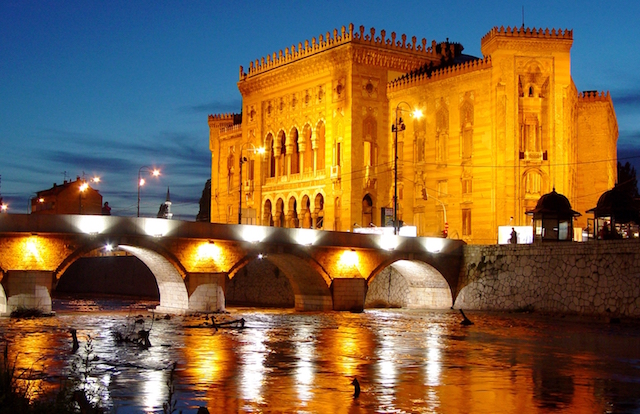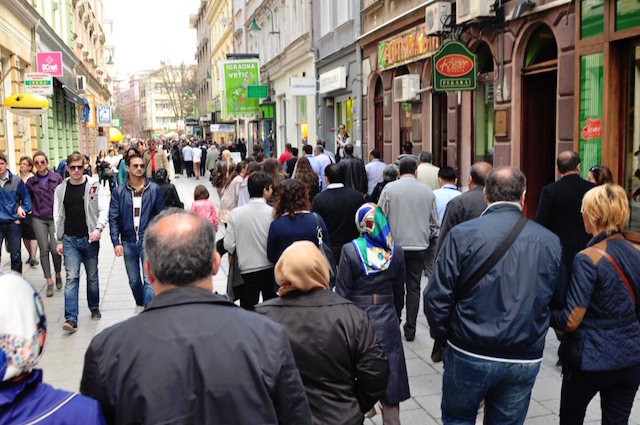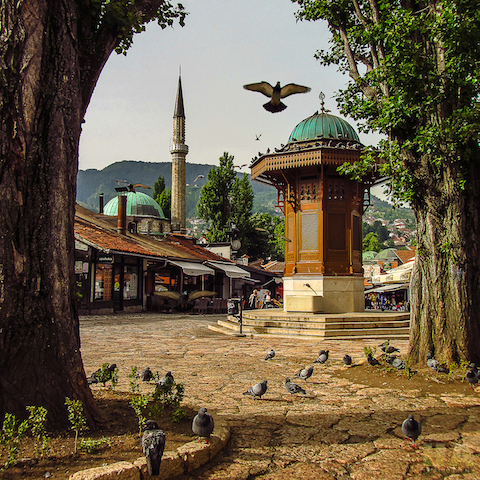Baščaršija

Bascarsija, also known as the Old Market, is not only one of the most important meeting and shopping centers in Sarajevo but also in all Balkans during the history. Famous Ottoman bazaar which was located in the center of Sarajevo, the capital of Bosnia and Herzegovina, was founded in the 16th century. It still is in use today and the heart of Sarajevo. It was one of the main targets that Serbian army tried to destroy during the Bosnian War. Bascarsija, surrounded by the Ottoman Mosques, has a Han (inn), a madrassa and many hospices which were built by Gazi Husrev-Beg. Known as the Turkish region, Bascarsija has a very nice Sebil which has become the symbol of the Sarajevo. Also it consists of many buildings that are the property of the Gazi Hüsrev Bey Foundation.
Careva Mosque
It was founded by Isa Beg in 1457 as a gift to Fatih Sultan Mehmet Khan. The original mosque was built like a large complex, including a “palace” (the name of Sarajevo derives from Saraj), a bridge, a caravanserai, a hammam, a han, a mill, a tekke(lodge) and various stores. Its present shape with several additions was given in 1566, period of Sultan Suleyman the Magnificent. The complex was rebuilt during Abdulmecid, by adding a library and expanding the tekke. Ulema council was added to the complex in 1912. Considered one of the architectural masterpieces of Sarajevo, the mosque serves as the Religious Affairs of the Bosnia and Herzegovina today.
Gazi Husrev Beg Mosque

The mosque was financed in 1531 by Gazi Husrev-beg, the provincial governor of Bosnia, whose tomb was located in the courtyard of the mosque. It was built by architect Sinan. Gazi Husrev Beg Mosque is located in Bascarsija, which is considered the heart of Sarajevo. Popularly known as the “Bey's mosque“, it is one of the prominent example of the Ottoman architecture. Serbian army purposely targeted all the cultural and religious monuments in Sarajevo during Bosnian war. As the largest and best known, the Beg's mosque was an obvious target. The mosque was restored in 1996 in accordance with the Ottoman architecture. Complex of the Bey's Mosque consists of the mekteb (Muslim primary school) building, and the muvekithana building (for prayer calling).
Alipasina Mosque
One of the most beautiful cupolaed mosques, built in 1561 beside the tomb of the founder of Bosnian governor of the sandjak province (sandzak bey) Ali-pasha. He died in Sarajevo in 1557, and prior to his death in the sickbed, he dictated his testament ordering thereby a mosque to be built next to his tomb with the funds from his foundation, which was obeyed.
Gazi Husrefbegov Bezistan
Extending over a length of 109 meters along the streets of the same name, Gazi Husrefbegov bezistan was built according to an order by the Bosnian sandzakbeg Ghazi Khusraw Bey, from the 1542 to 1543 years. It has 52 shops arranged in two rows inside the building and a third series of shops on its outer side. It sells textiles, mainly imported goods.
National Museum of Bosnia and Herzegovina

National Museum of Bosnia and Herzegovina was founded in 1888 during Austria-Hungary period. Following the founding of the National museum during the last century it has been able to collect and preserve a large part of the national cultural heritage of the country. The construction of the museum began in 1909 and was completed in 1912 and mansion type museum consists of a botanical garden located in the middle of four separate buildings. Botanical garden contains many endemic plants from Bosnia and all over the world. The tomb stones exhibition was open to the public on 1 October 1913. One of the most important exhibits in the museum is the famous Sarajevo Haggadah, the traditional Jewish book by the Sephardim brought to Sarajevo by his exile from Spain. Museum suffered from serious damage in the war between the years of 1992-1995.
Brusa (Bursa) Bezistan
With six-domed structure, Bursa bezistan is one of the most interesting architectural monuments in Bascarsija. It has rectangle-based architecture and contains entrance from four different streets. It is able to connect the streets of craft because of its occasion. It was built in 1551 by order of the Grand Vizier Rustem Pasha. The name Bezistan was derived from Bursa, where silk trade is famous.
Museum Alija Izetbegovic

Museum Alija Izetbegovic as an extension of the Museum of Sarajevo was opened four years after the death of the president, on 19 October 2007. Alija izzetbegovic and his monuments such as photos and personal belongings explaining his life and struggle were exhibited in Tower Ploca and Sirokac, known as Vratnik Gates towers which are old Ottoman fortress near to Kovaci Cemetery. Svrzo House, Glodina 8, Sarajevo Centre 71000 Svrzina House is one of the most important examples of traditional Bosnian architecture in Sarajevo. It is the best example of house remaining from Ottoman Period of Bosnia.
Roman Bridge
While Goat Bridge symbolically represented the eastern entry of Sarajevo, the Roman Bridge represents the western entry. This bridge, located on the Bosnia River, belongs to the architectural heritage of the Ottoman period. It was built between 1530 and 1550, and until today it has retained its original shape. The construction of the bridge was ornamented stones from the Roman period, that it why the bridge is better known as the "Roman Bridge". National and University Library of Bosnia and Herzegovina Constructed in the period Austro-Hungarian Empire as a municipality building, it represents the architectural style of Bosnia and Herzegovina in that era. The building which was opened in 1896 served as municipality building until the end of the Second World War then served as the National Library. Burned and damaged building during 1992-1995 war in Bosnia has been restored nowadays.
Morića Han

In the 16th century also called "golden age" of Sarajevo, there were over 50 hans (Inns). Only Gazi husrev Beg han has survived until today. It was constructed as a facility that provided shelter and hospitality merchants and travelers in the first half of the 16th century. It fulfilled all requirements for a Han in those days: large enclosed square yard, storerooms and areas for horses on the ground,on the upper floor rooms for sleeping. Han had 44 guest rooms with 300 beds. It was burned in a fire in the 1957 then renovated in 1970s.
Sebilj ( Fountain)
Sebilj, which has become a symbol of the city, was built in 1891.The original Sebilj built by Kukavica Vizier Mehmed Pasha in 1754, which was located slightly below from the current location of the Sebilj was destroyed in the fire 1852.
Svrzina House
Svrzina House is one of the most important constructions which symbolize the culture, life style and philosophy of the period before Europeanization. Mansion which is a beautiful example of Ottoman life-style has interior courtyards surrounded by high walls, haremlik (the part of a house for women), selamlik (the part of a house for men), and interior decorations. It is one of the rare structures that have managed to maintain its authenticity.
About Sarajevo
The cultural and historic heritage of the city of Sarajevo dates back from the following historical periods:
1 Prehistoric and Roman Period
2 Ottoman Period
3 Austro -Hungarian Period
Prehistoric and Roman Period
Butmir, Neolithic archeological site near Sarajevo, is one of the biggest Neolithic archeological sites in the Balkans. Its original inhabitants lived here from 2400-2200 B.C. It was discovered in 1892-95, and during a few years of exploration 95 sod-houses were discovered with findings of stone weapons and ceramic pottery, decorated with spiral motifs.
The biggest archeological finding of classical culture is located near Sarajevo at Ilidza. This is a municipal resort, situated at the important transit roads Via Argantaria - Narena. The conference venue is also located in this suburb of sarajevo. According to some research it is assumed that it was called "Aquarum Sulphuratae"- Aquae S.
Otoman Period
City of Sarajevo was set and build by Ottomans in 1463 and majority of the buildings and monuments in the old city are from this period. The most important Ottoman structure is Begova Mosque. On the place of today's mosque there used to be a mosque with a hipped roof, built by Isabeg Ishakovic in second half of the XV century. Today's mosque with a dome above the prayer area and three small domes on the cloister was built in 1566 by the order of sultan Sulejman Velicanstveni (Suleiman the Magnificent). It is distinguished by its architectural values, varied base, multi dome system and courageous construction from all sub-dome mosques built in the region. The cloister surrounds the mosque's courtyard. Two sides of the cloister are walled up in 1847 and in 1912 the building of Ulema Medzlis was expanded as well. The architect was Karl Parzik, who respected the form and module of the mosque. The minaret is octagonal and it is one of the most beautiful in this region.
Other important mosques are: Muslihudin Cekrekcija mosque was built as the second mosque with a dome in Sarajevo in 1526 in Bascarsija (Old City) area. The mosque has a shallow dome and is surrounded by stores. Havadze Duraka Mosque in Bascarsija was built in the mid-XVI century. Originally the mosque had a wooden dome which was destroyed in the attack by Eugene of Savoy in 1697. The mosque acquired its present look with the stone dome, after World War Two. Ferhadija Mosque was built by Ferhad-Bey Vukovic-Desisalic, the Bosnian governor of the Sandzak province. This mosque has one dome above the prayer area and three small domes at the cloister. The mosque has preserved its authentic arabesque and stonemason's ornaments. It was damaged in the 1992-95 war. Ali-Pasha mosque was built by Hadim Ali-pasha, the governor of the Budapest administrative district in 1560-61. The mosque is built in classical Istanbul style. Sejh Magribija's Mosque was built at the outer west end of old Sarajevo (today's Marindvor) in the mid-XVI century.

Sinan's Dervish House (Tekija) is a house for dervishes of the caderian order. It was built by Hadzi Sinan-aga, a rich Sarajevo shopkeeper or his son, Mustafa-pasha, armourer of Sultan Murat IV's court. The special calligraphic decoration, on the walls of the monastery dates from the XVIII century.
Kursumlija Muslim Secondary School (medresa) is one of the most known example of 70 Muslim primary schools (mekteb) and 12 Muslim Secondary schools (medresa) in Sarajevo built by Ottomans. The most precious building in architectural style was the Muslim secondary school built by Gazi Husrev-Bey in 1537, across the street from his mosque and dedicated to his mother Seldzuka. The school was named after her, but the nation called it Kursumlija, due to the lead roof. The school was built in the classical style in which the Muslim secondary schools were built, with cloister and columns around the central atrium, and twelve class-rooms and dershana (school-teaching halls).
In addition, there are many Hostels (hanovi) and resting places for caravans (karavansaraji) in Sarajevo built by Ottomans. These were used as accommodation for voyagers and goods. Resting places for caravans offered a three day stay for free. In Sarajevo there were 50 hostels in 1878, 45 of which were in the city territory. The first one that was built is Kolobara hostel (in 1462), and it could receive 400 people and 35 horses. Than there was Gazi Husrev-Bey's hostel - Taslihan, next to the covered market place (bezistan), of the same name. Taslihan was built in 1543, and it was covered by semicircular ceiling. It was seriously damaged in the fire in 1697. After the fire in 1879 it was not renovated, and was demolished in 1912. There are some ruins in the yard of the hotel "Evropa". Subsequently there were Morica hostel, Skender-pasha's resting place for caravans, Kemal-bey’s resting place for caravans (karavan-saraj, hadzi Besir’s, Pehlivanov’s and Despica’s hostel and many others. There are also many hamams (baths) and libraries built by Ottomans. Unfortunately many of these structures were destroyed or damaged during the war in 1992-95.

The Orthodox Cathedral was built in neo-baroque style in 1872. It was built by the Macedonian Dimitrov, who built Military barracks as well, for which he was decorated by the sultan. As it was damaged in the 1992-95 war, the Greek government ensured the fund for the reconstruction of the church in 1999.
Catholic Cathedral of the Vrhbosanska archbishop's diocese consecrated to the Most Holy Heart of Jesus was built in 1889, according to the design of Josip pl. Vancas in the new Gothic style with new Romanesque elements. The building was lightly damaged in the 1992-95 war, but today is completely reconstructed.
Saint Josip's church in Sarajevo is the work of the architect Karlo Parzik, the author of numerous historical achievements of Sarajevo. This sacred building interprets the new Romanesque style, and by the varied mass and volume relations it remains a valuable architectural achievement and important urban point of this part of Sarajevo. As it was damaged in the 1992-95 war, restoration activities are being performed on the church.
Sephardic Jews that were being persecuted in Europe came to Bosnia and Herzegovina in XVI century, when these regions were part of the Ottoman Empire. Received warmly, not only by the official authorities but also from the local people, they have remained in these regions for centuries. They settle down at Sijavus-pasha neighborhood, where they built the Old and New temple. The Old temple was built in 1580, but it was fired twice (in 1697 and 1788). Because of that the new temple was built in 1821. The interior of the temple is divided into three naves, and central part is covered by a curved ceiling. In World War Two it suffered severe damage from the Nazis. Today, the Jewish museum is there.

Ashkenazi Synagogue was built in 1902 according to the design of Karlo Parzik in pseudo Moorish style, and it is located on the left bank of the river Miljacka. It was severely damaged in the 1992-95 war.
Austro - Hungarian Period
The Post Office: The plan for the Military telegraph and post, the most representative palace of Austro- Hungarian time was designed by architect Josip pl. Vancas (1907-1909). The author of numerous architectural achievements in Sarajevo, Vancas took its example from the Viennese Post saving bank, remaining consistent with the classical spatial concept. He divides the facades into joints by pilaster systems and window openings, decorating them with sezession floral motifs. The most precise part of the palace was the window auditorium that was distinguished by its proportions and rich architectural plastics.
National Museum: The national government established the National Museum in 1888, and in 1912 its collections were transferred to the new building, designed by Karlo Parzik. This respected architect of Sarajevo, by applying historical styles to the public and residential buildings, achieves a special value building by the complex of the buildings of National Museum. Symmetric composition of four pavilions, where each has special proposition, forms the internal atrium with a botanic garden. These buildings although independent are connected by the terraces and create the compact spatial and harmonic entirety. The whole complex has characteristics of the new Renaissance style. It was heavily damaged in the 1992-95 war.
Tunnel of Hope (War)
The Sarajevo Tunnel was constructed between March and June of 1993 during the Siege of Sarajevo in the midst of the Bosnian War. It was built by the Bosnian Army in order to link the city of Sarajevo, which was entirely cut off by Serbian forces, with Bosnian-held territory on the other side of the Sarajevo Airport, an area controlled by the United Nations. The tunnel linked the Sarajevo neighbourhoods of Dobrinja and Butmir, allowing food, war supplies, and humanitarian aid to come into the city, and allowing people to get out. The tunnel became a major way of bypassing the international arms embargo and providing the city defenders with weaponry. After the war, The Sarajevo Tunnel Museum was built onto the historic private house whose cellar served as the entrance to the Sarajevo Tunnel. Visitors can still walk down a small length of the tunnel (approximately 20 metres). The "house" museum exhibits archival materials including an 18-minute long movie, war photographs, military equipment, flags, military uniforms, and flotsam and jetsam. In 2004, local planning authorities were seeking funding for a "full reconstruction of the tunnel" and the "construction of museum buildings at its entrance and exit points". Regarding the museum's purpose Vladimir Zubić, deputy of the City Council of Sarajevo, noted that the museum is "a reminder of everyone, so that a thing like this tunnel, that provided the people of this city with the minimum subsistence, will never have to be used again. It will be a place where younger people will be able to study a part of our recent past and it will be proof that this part of our history will never be forgotten". The house and the land around Sarajevo Tunnel's entrance are owned by Bajro Kolar, a local man who runs the private museum. In a documentary about the Sarajevo War Tunnel, he talked about his reasons for turning the house into a war facility. He said, "whatever we have, we gave for the defense and liberation of Sarajevo." Having existed for 15 years without any governmental financial support, the museum is becoming one of the most visited sites of the Bosnian capital, with hundreds of daily visitors. Many guided tours in Sarajevo include the Tunnel Museum as one of the war sites most worth visiting in the city. The museum is open to visitors every working day from 9am to 4pm.

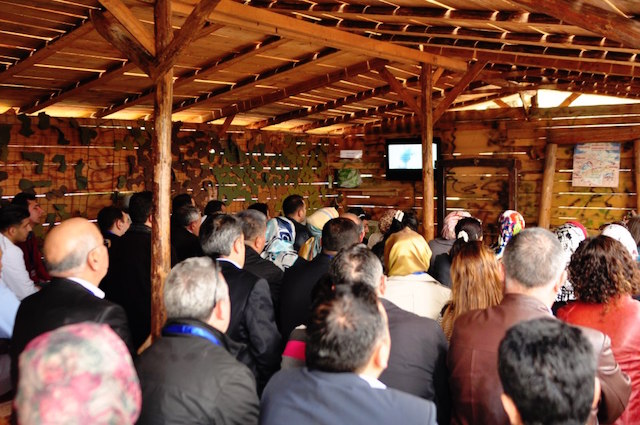
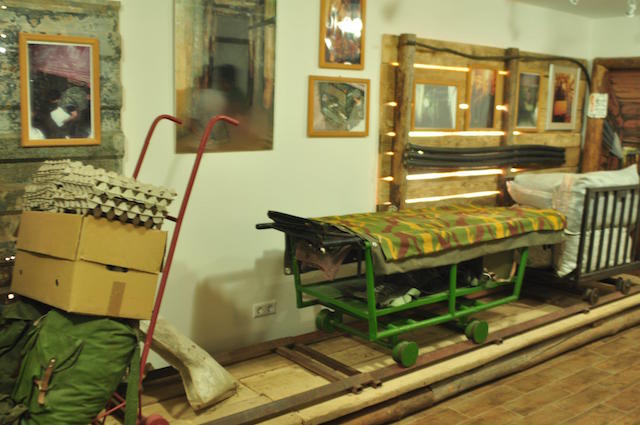
Source: https://en.wikipedia.org/wiki/Sarajevo_Tunnel
